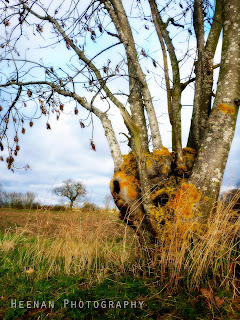Friday, 8 February 2013
Agrarian Veteran
I took a turn about the fields in the Chignal Smealy area last Saturday, and managed to capture this photo of a stunning veteran tree. The only way is Essex countryside!
The weather was blustery and cold, and there were dark clouds looming overhead. I thought to capture some photos of the dramatic skies over the fields, but in Winter the arable fields can be quite bare. Then I happened across some charming old trees, or perhaps tree (the trunks may have been part of one coppice stool beneath the soil) beside a ditch. The knobbly, weathered trunk sported some dazzling lichens, a small ray of sunlight on a wintry day. The fresher branches arch out to the left with a delicate drapery of last year's seeds, more keys to the past seasons of growth. This tree had faced many cold Winters, and Summers fair, and I'm sure it had seen much from its position overlooking the agrarian activities of the neighbouring fields.
In Norse mythology, the world sits on an ash tree. The ash, Fraxinus excelsior, sounds rather grand when named in Latin, and indeed it can be a rather grand tree in form. Naturally these trees live to just 250 years or a little beyond, but some of the coppice stools will persist for much longer and some suggest that the older coppiced ash stools may be at least a thousand years old - amongst the oldest living things in Britain. Indeed these trees can be remarkably resilient, bouncing back from disasters like lightning or severe storms, and this can result in some contorted shapes and growth forms. Whilst the trunk itself may only be one or two centuries in age, it is possible that the stool or roots beneath the ground could be far more ancient in these cases. So while the tall maiden Ash trees may be most impressive in size, the more venerable trees may rather be those that have been brought low by men or circumstance.
For those who haven't heard, there is a threat to British ash trees, the Chalara fraxinea fungus or "ash dieback". This was first discovered over here last year, although it has been known in mainland Europe since the 1990s. If the disease has a similar impact in Britain as it has had in Denmark and Sweden, the British countryside could see a change as drastic as that caused by Dutch Elm disease forty to fifty years ago. To read more about ash trees and the Chalara fungus, you can read this Times article and visit this Woodland Trust page.
[View the photo gallery]
Subscribe to:
Post Comments (Atom)


No comments:
Post a Comment